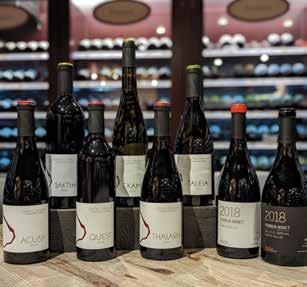
4 minute read
5 Questions for Raül Bobet of Castell d’Encus and Ferrer Bobet
Interview by Gary Hewitt, DipWSET, CWE, FWS, Sommelier
Raül Bobet is an engineer, winegrower, and philosopher. After working with renowned Catalan winery Familia Torres as a technical director and later as CEO, he decided to strike out on his own. Using a careful, scientific approach, he looked for varied terroir to provide grapes with a broad range of characteristics. First, he established Castell d’Encus in Pallars, a high-altitude sub-zone of the diverse appellation Costers del Segre, nestled in the Spanish Pyrenees. There, on terrain covered by underbrush, he discovered shallow stone basins carved and used for winemaking by 12th-century monks. Today, Raül blends grapes from these “gravity rock fermenters” with those fermented using contemporary techniques to create his wines. Second, with partner Sergi Ferrer-Salat, he established Ferrer Bobet in the relatively high, steeply sloped Porrera region of Priorat, Catalan’s most prestigious appellation.
1What do you know about the monks who first planted in the Pallars area in the 12th century?
The monks that acquired the land were warriors—they were the Knights of Malta, the army of the Pope of Rome, who took part in the Crusades. And when they asked for land, they always wanted two things: for it to have a religious or spiritual history and water and resources to make wine. They always chose places that were spectacular in some regard.
We know exactly what they were doing in the 12th century because they wrote it all down: they planted in the mountains, never in the valley; they used gravity rock fermenters; and they wrote about the varieties they were using and their methods. We know from the literature that they were blending red varieties, sometimes with white varieties, but they were called other names. We know that in this area, they planted Hondarrabi Beltza, a Basque name that translates now to Cabernet Franc, which is one of the oldest varieties to exist.
2
What did you have in mind when you were searching for vineyard sites?
My main goal in the 90s was to make wines with more acidity and more longevity, not trying to impress people with fruit, either from the structure or extraction. I began looking for an area where I could find extremely different types of soils, especially calcareous (limestone-containing) soils. At the same time, I could play with the very different altitudes provided by the Pyrenees. The key is not just getting very high in elevation. Sometimes getting too high makes an uninteresting wine. The microclimates, the mesoclimates, the interrelationship between mountains and plateaus—all of these things change what you are going to do.
3
Are there specific challenges to growing grapes at high altitudes?
I know that when I’m getting very high in elevation, in a very cold year, maybe I will not be able to harvest, or the quality is not going to be there because it’s too cold. This is the reality. But you have to play with that, and you have to be humble enough to admit that when you go to a very high elevation, in cold years, sometimes you have to disregard some of what you are thinking. This is why I’m playing with these patches of heterogeneity—which is very easy to say but extremely complex from a human resources and logistics standpoint.
5
Can you describe your winemaking philosophy?
With a brain, a team, and soil, you can create what you want—but you need patience and method. And you cannot forget a holistic point of view. The most interesting variable is finding the music in your mind, and that music is: what type of wine do you want?

4
You have two projects: Castell d’Encus and Ferrer Bobet. Both are considered to be high-altitude projects, even though there’s a considerable difference between them. Can you elaborate on the difference between the two?
There are some similarities. But when we went to the Priorat, we were specifically looking for Carignan (a red vine variety), which has a very good capacity for aging, although the disadvantage is that if the soil is too rich, it is not interesting at all. But using very old vines in very poor soils, in this case, we found magic. So, we were looking for a very specific place. In Porrera, the weather is the coolest, and there is a late harvest. Porrera is also one of the highest areas—though, of course, not as high as the Pyrenees.
First, you have an idea of what you want. If you are playing with Shiraz, you have to decide if you want the spectacular Barossa Valley wines or if you want a style that plays more to a Côte Rôtie or Saint Joseph (from the northern Rhône in France). One style has nothing to do with the other. Second, you don’t pretend to copy anything: you have to interpret your music once you have it. You have to be very conscious about the genetic material and also where you are planting it, when you’re going to harvest it, and what exposure you want. For this style, you are not looking for fruit; you are looking for spiciness and moderate alcohol. So, you put together the elements from nature to get there. Nature dominates you— you never can control it 100%. Sometimes this means that you will have to disregard some pieces of the music as you go along.
This is how I construct wine: everything is based on the music in my head. You can never find perfection because that doesn’t exist. But you dream every year that if you have all these different frequencies, maybe some night, walking through the cellar, you will have the inspiration to construct this perfect thing that you have in your mind.







